Challenging the Notion of Ineffectiveness of Government Schools: A Case Study
By: Vipin Kumar Chauhan and Ananas Kumar
1. The context of government schools and perception of parents
In India, school education has seen several state and nation-wide programs in the last three decades for increasing access and retention of children and to deliver an education of desirable quality in government schools. Many of these programs have significantly achieved access and retention of children but a lot is yet to be achieved to improve the quality of teaching and learning. Revamping of teacher preparation programs, development of child-centric textbooks and provision of locally contextualized annual teacher trainings for all in-service teachers are some of the initiatives to impact the current level of students’ learning. Despite this, parents still consider the densely-distributed, low-fee private schools, which they call as English-medium schools, a better choice than government schools, which might not be so.
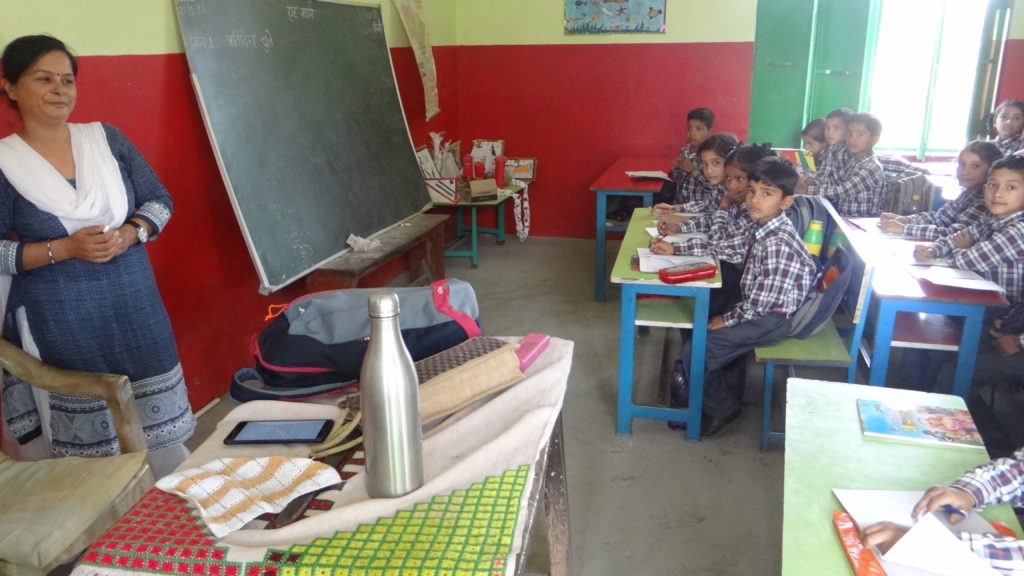
This has resulted in the declining interest of parents, including those from the economically vulnerable communities, who cannot afford private schooling (EconomicTimes, 2018) in the government schools. The studies conducted so far to investigate and analyse contemporary issues and challenges in the Indian education system have pointed out multi-layered issues, like lack of quality education, corruption, poor women’s education, lack of facilities, curriculum issues, workforce absenteeism in public schools (Nadar, 2018).
The low priority given to school education in agendas set by the government has significantly deteriorated the trust of people, especially, parents of new entrants. Most parents have a strong feeling regarding the inefficiency of education being provided in government schools and of the private schools as being a better alternative for the education of their children. The private schools have taken it as an opportunity to market their schools. This has resulted in an increase of 17.5 million children in private schools from 2010-11 to 2015-16 (Saha, www.business-standard.com, 2019).
2. A ‘different’ government school
Government schools have been criticized for their deteriorated quality of education. The ASER report for last several years and NCERT annual achievement surveys have provided evidence that depict issues in even the basic competencies of reading and writing. There are government schools, though limited in number, which have changed this notion of their ineffectiveness. A recently published article on the government school (Eram, 2019) in Biwan (Mewat district, Haryana) highlights the shift. On similar lines, the government primary school in Pataliya village in the Kotabag block of Nainital in Uttarakhand has also proved this. Within one month of starting the admission process in 2018, the school had to stop taking more admission because the seats were full for all classes. The school has not only gained the trust of parents but has encouraged other government schools in the district to adopt the practices it follows.
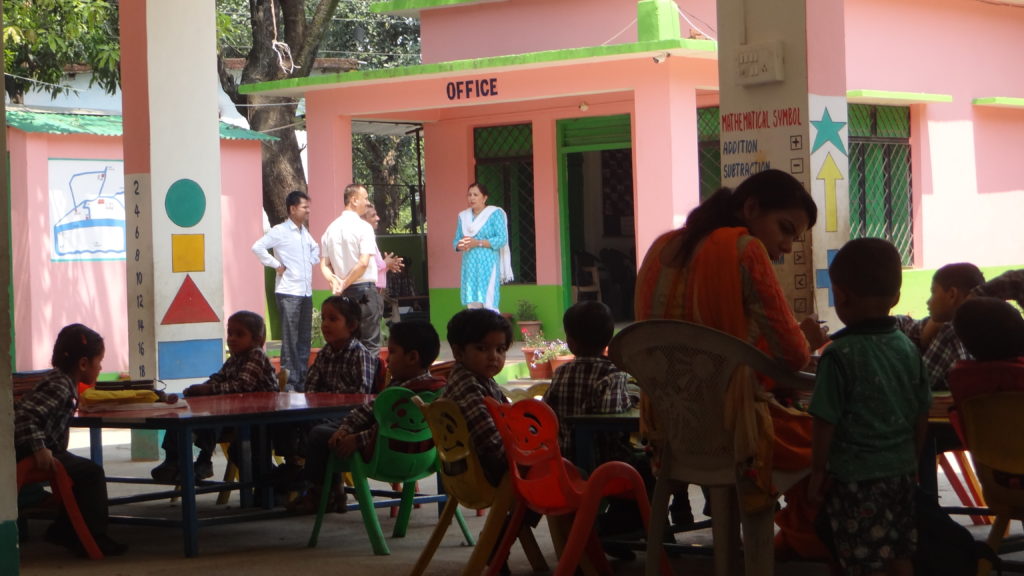
The enrolment figures in this school have risen from 20 children, all from labourers’ families, to 224 in the last five years (as on 11 May 2019). 174 of these children are in classes I-V and 50 in pre-primary classes. An important aspect of the increase in enrolment in the school is that it now has children from all sections of society, regardless of their socio-economic profile.
The notion that government schools are meant for children from poor and disadvantaged backgrounds only, has been proved wrong by the school. The children who attend this school are either those who have left private schools or those who have sought first-time admission in kindergarten or grade one. The head teacher of the school, despite the fact that her husband also runs a private school for children of elementary grades in the vicinity, has been able to pull out some children from there too. Recognizing the achievements of the school, this school has been declared as ‘Model School ’ under a special drive led by the Government of Uttarakhand since 2016-17. She says: ‘We have made our government school of a certain standard that even some of the children from our family’s private school have come to my school and they are now continuing their education in this school.’
3. How the transformation came about
The transformation of the school and the changed perception of the community is the outcome of a well-thought-out strategy evolved and executed by the Deputy Education Officer (Dy EO), Amit Kumar Chand of Kotabag block, Anurag Palariya, Block Resource Centre Coordinator (BRCC) of Kotabag, the head teacher and teachers of the school and the representative of the School Management Committee (SMC). This strategy focuses on three broad components of school processes.
1) Transforming physical set-up of school.
2) Strengthening the school-community relationship.
3) Focus on learning of every child.
The Deputy EO has been the key player in the implementation of the strategy and has gone beyond his call of duty; and, without negotiating with the existing rules and regulation set by the Education Department. An example for this is that the government schools are not allowed to run pre-primary classes but he, in consultation with the SMC, took a decision of starting the pre-primary section so that no child is away from school just because the school does not have an opportunity for them.
2.1 School infrastructure
The school functions in a double storied building equipped with CCTVs in all corners to address safety and security. All the classes are held in separate, spacious classrooms. The students have furniture to sit comfortably on. Separate toilets are available for boys and girls on both floors. There is an auditorium on the school campus equipped with a projector, which is used often by the teachers for large group interaction or whenever a better engagement of children requires the use of audio-visual aids. The children who come from far-off places use the school bus managed by the school. Some of the children even come from as far as 8 km. The expenditure on daily transportation of children (a maximum of Rs 500/- per child) is paid by parents since the provision was made in response to their request. In cases where children are not able to afford the transportation charges, they are provided with the facility free of cost.
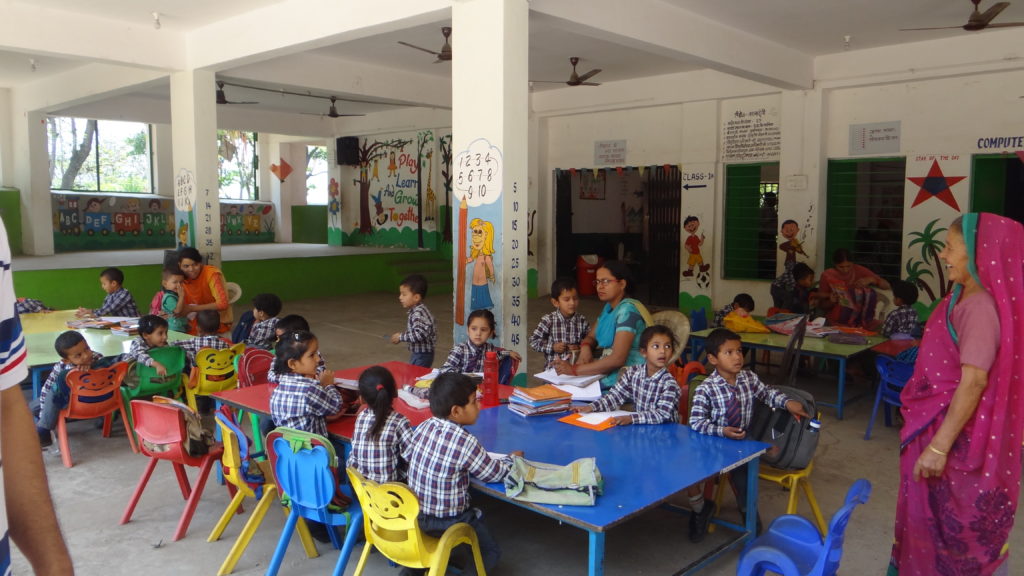
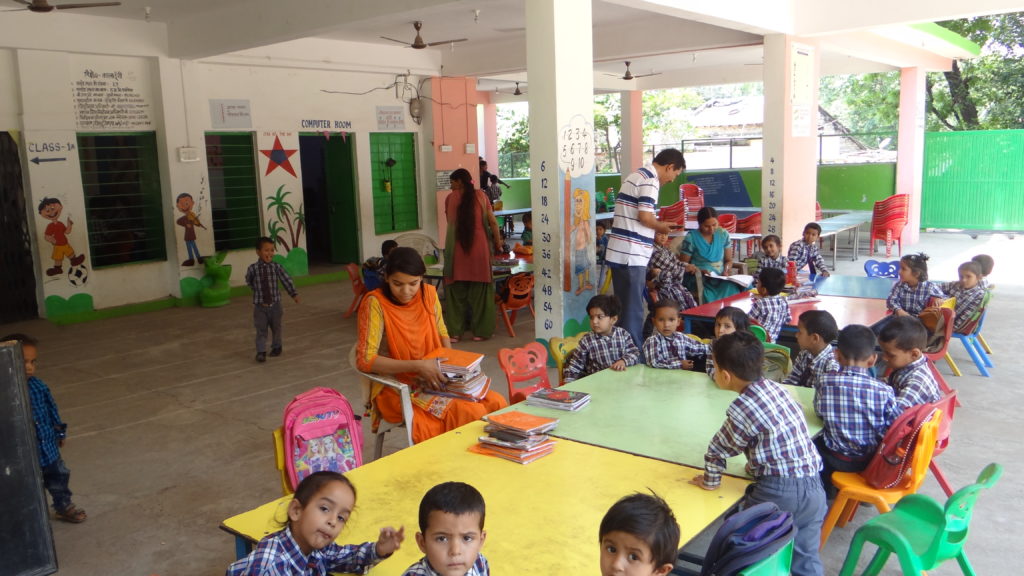
In 1900, the school was provided ample space for school activities by the British government, but a big proportion of this land has now been encroached by the locals, permanently. They have built their houses on this land and the school now runs on a limited piece of the allotted land, which is not enough to carry out outdoor activities for children. The head teacher of the school, recognizing the importance of space for outdoor activities, has purchased half-a-bigha (one bigha is less than one standard acre) land for the school. The school managed to get this amount of fifty thousand for buying the land from the Ram Leela Committee of the village. The total cost of the land is Rs. 1.25 lakh. The rest of the payment, approximate Rs 75,000 is managed by the head teacher from her personal sources.
The mid-day meal is served in a well-designed dining hall and food is served by two Bhojan Matas. The quality of food is closely monitored by the head teacher and there are regular changes in the menu. This has changed the food habit of some students and they are now open to trying a variety of foods. A water cooler has also been installed for safe drinking water to children and school staff.
My son has always been very fond of south Indian and Chinese foods. He hardly likes north Indian foods, our routine food. After coming to this school, he has changed drastically. He is now quite open to most of North Indian foods, especially Dals which he never liked before.” – A student’s father who owns a hardware shop.
2.2 Building a strong school-community relationship
The head teacher and teachers went door-to-door in the village to talk to parents and families and increase enrolment in the school. The Deputy EO shared that they have some understanding of why parents do not send their children to government schools. He cited some of the major factors as:
- Government schools do not give admission to children below six years of age, so parents admit their children to private schools and the children stay there even after they cross age six and are eligible for admission to a government school.
- The children also do not want to move schools. There have been cases where parents have agreed but children have refused to move to a new school.
- The parents’ perception is that government schools are meant for the poor only. They feel the teachers do not make adequate efforts to teach sincerely.
To deal with these issues, the SMC decided to start the pre-primary sections. Their classrooms space and furniture for these sections were made attractive, just like it is in private schools. The Deputy EO enrolled his child in the pre-primary section so that others would be motivated to do the same. The BRC Coordinator, the head teacher and the Gram Pradhan of the village also enrolled their children in the school. To run the pre-primary section efficiently, an adequate number of teachers were appointed. The parents were assured that once these kids are in grade one, all government school norms will apply to them and that the school will not charge any fee for any of the facilities except the transportation charges. The amount so far collected for admission and the monthly fee was used for recruitment of teachers on an ad-hoc basis. The spouse, Guddi Chand, of the Deputy EO expressed her willingness to teach the pre-primary children graders without honorarium. This immediately had two benefits – one, it significantly helped in boosting the motivation amongst teachers (ad-hoc) appointed for the pre-primary section who were being paid much less even while they are doing the same job as the permanent teachers and second, it also boosted the motivation of the government teachers in improving their own teaching practices when they saw how greatly the ad-hoc teachers in the same campus were contributing even on low or no honorarium.
The strategy of the Deputy EO enrolling his son in the pre-primary section worked well and the school started getting children for pre-primary sections. These were children from different backgrounds. Surprisingly, the parents of these children were initially criticized by their neighbours, relatives and even by some of the senior officers in the Education Department that they were ruining their children’s lives.
There was also a realization that the parents were paying more attention to their children’s learning to see whether the school was doing what it had committed to. This created a positive pressure on teachers and head teacher to keep their commitment high. Many parents started regularly visiting the school to discuss the progress of their children with the teachers.
2.3 Focus on the learning of every child
The school recognizes well that all their efforts can sustain only if the students learn better in the school and it should be reflected in their knowledge, thinking and behaviour. If this happens, it will have a long-lasting impact in building the trust of the community. The Deputy EO designed the approach ‘Every child learns every subject’. He made a three-tier plan in consultation with the head teacher, teachers and the members of the SMC to implement this efficiently. Initially, there were two teachers posted in this school for five classes. He reviewed the availability of teachers in his block and noticed that there are two remote schools from which teachers could be transferred to this school. Teacher transfer in Uttarakhand is a complex issue, so the case was discussed with the District Magistrate of Nainital District and the school got more teachers. After this, he had a round of meetings with the school staff to make them aware of the expectations from them and the need for them to devote their maximum time with the students.
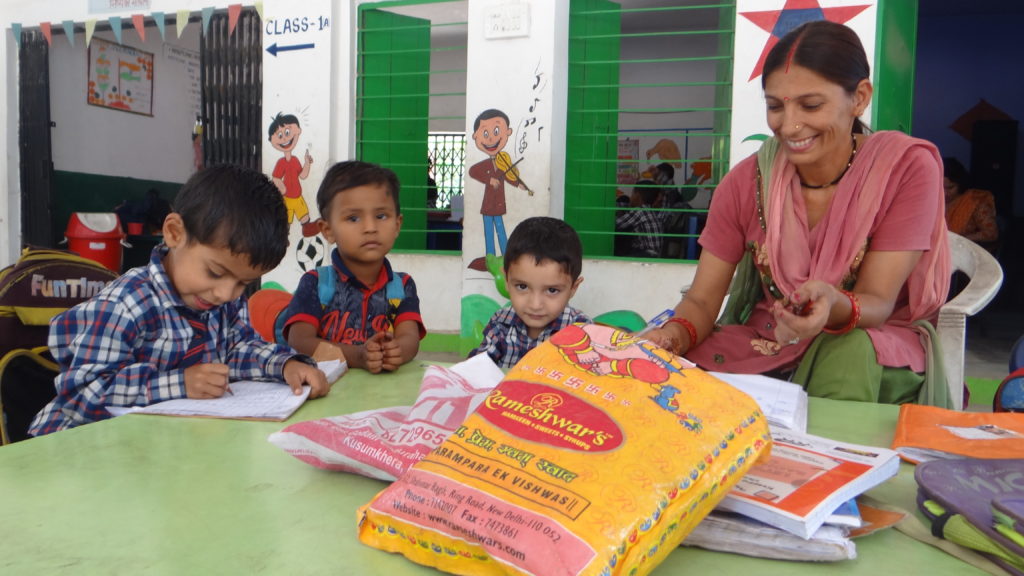
When faced with the issue of what to teach in the pre-primary. The head teacher looked at the curriculum of various private schools and designed a curriculum based primarily on the syllabus followed by an Army school based in Haldwani town of the Nainital.
In school, the teachers were given adequate freedom to perform better by following some common principles. This gave them a feeling of ownership.
- It is primarily the head teacher who takes care of all administrative assignments. She regularly reviews formative and summative assessment of every child to stay informed of the learning level of children and to identify issues that need teachers’ attention.
- The teachers are not burdened with non-teaching related tasks.
- The head teacher regularly interacts with teachers and understand their day to day challenges.
- The head teacher appreciates the best practices adopted by the teachers.
- The teachers maintain a non-threatening environment so that children love to come to school daily.
- There are a variety of activities so that every child has the opportunity to participate in as per their interest.
‘The autonomy of teachers has transformed the learning level of children in this school. When children from this school go to upper primary schools in sixth class, they are easily absorbed in their setting. The teachers from those schools appreciate the active involvement of children in their school. We see this as an achievement for our school.’ – The Deputy EO, Kotabag.
3. Additional initiatives
The school has also started preparing children for admission to the Navodaya Vidyalaya and three of the students have already qualified the test. Now they wish to prepare all class five children for all competitions. The school has also increased focus on spoken English, computer skills, as desired by the parents and agreed by the SMC.
The school has rebuilt its image among parents, who are proud to state that their children study in this school. Other government schools in the block have also taken some steps to make their schools better. One of the best examples is the public school of Ginti Gaon, which is about three kilometres from this school. This school was earlier known as a school for Scheduled Castes children. Inspired from the learnings of Public School Pataliya, the teachers in Ginti Gaon have rejuvenated their school, whose enrolment has grown to more than 80 children from 17 children, two years back.
The head teacher first focused on school building and construction of a well-maintained boundary wall with support from the member of parliament through the Gram Pradhan of this village. Post her interaction with residents, she changed the textbooks of her school from Hindi to the English language. As there was no English teacher in the school, she with support from the school management committee, appointed a contractual qualified and experienced teacher for teaching English in her school. Inspiring from the learnings from public school Pataliya, she also started a playgroup and got an opportunity to enrol 30 children in the same year. The Deputy EO has helped her in managing four permanent and four contractual teachers. Residents from local villages have gifted CCTVs, fans, water tanks, etc. to this school. One of the eminent personalities of the village also provides Rs. 5000 every year for maintenance. The school on request of parents also provides transportation facility for children, for which they charge Rs. 300 per month. In similar lines, the government schools in Maya Rampur, Bail Pokhra, Paval Garh and Dhanpur village have taken several initiatives to reform their schools.
4. Pillars of change: Principles, learnings, and achievements
The journey of the last five years of the Government School, Pataliya provides insights for other government schools and administrators to follow in order to regain the trust of parents who would proudly send their children to government schools by choice and not due to compulsion. Some major aspects that the key stakeholders of the Government School, Pataliya felt necessary for improving the school performance are the following:
- The leadership at the school and the block level is crucial for transforming government schools. The Deputy EOs can visualize the journey of change in their administrative territory in coordination with the headteachers.
- Many schools use short-term alternatives to attract children from nearby private schools. This does not work in the long term. Schools need to upgrade their teaching-learning practices for a better perception in the community. This will itself create demand in the community.
- Teachers in government schools are well-trained and professionally more mature than those in many private schools. They must seek practical solutions for problems and go beyond mere instruction in the classroom. The government schools of Pataliya and Ginti Gaon have emerged as an example.
- The education officers must win the teachers’ trust. The teachers must feel that the officers are on their side and ready to provide support whenever they require it.
AUTHORS
Vipin Kumar Chauhan, Resource Person – Research, Azim Premji Foundation, Dehradun, Uttarakhand.
Ananas Kumar, Resource Person – Research, Azim Premji Foundation, Udham Singh Nagar, Uttarakhand

